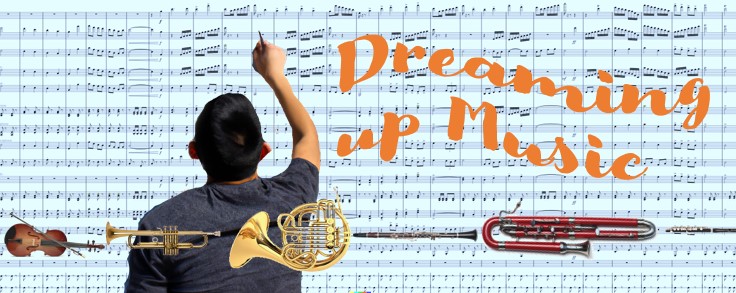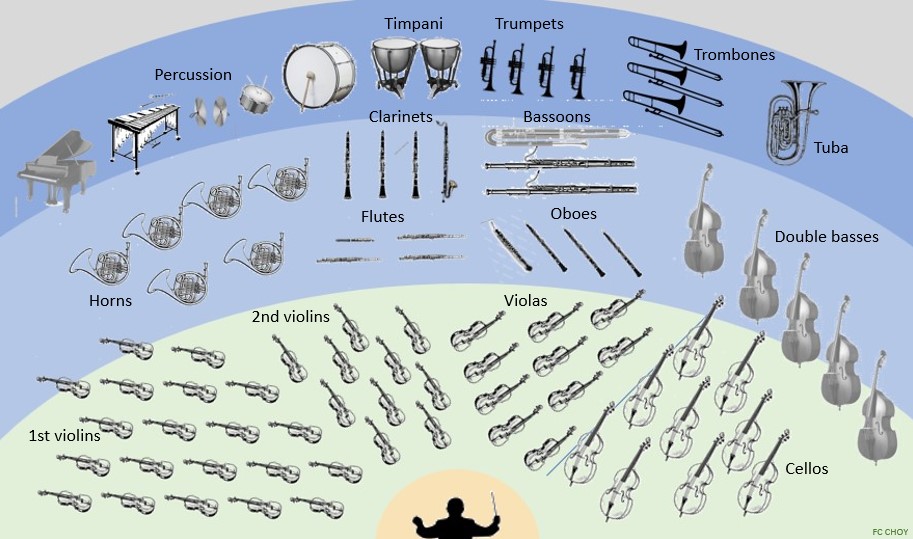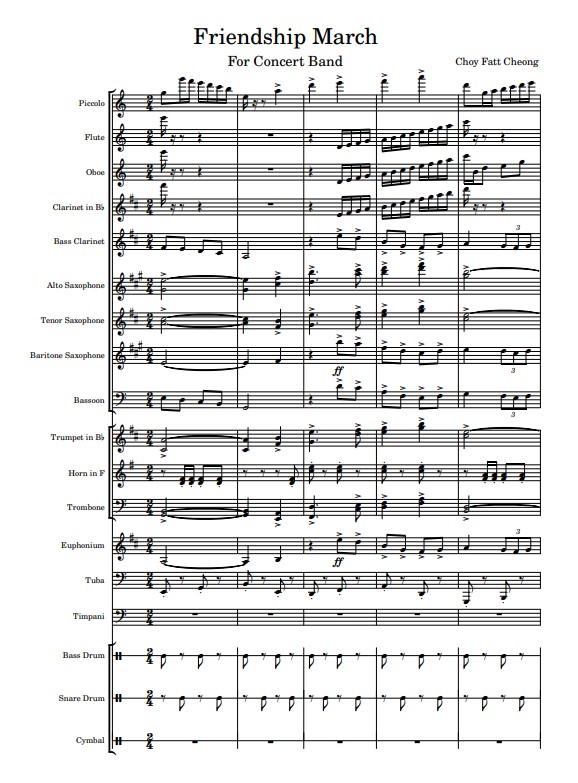Dreaming Up Music

There are diagrams that explain how things work, diagrams that show the lay of the land, diagrams that explain complex ideas quickly when words fail, diagrams that give you sudden insight, and many others. But there is one type of diagram that stirs up a lot of joy and imagination in me—the orchestral seating plan.

When I started playing music in my school band as a teenager, I became fascinated by the variety and complexity of sound produced by large instrumental groups. Though I had not heard a live orchestra before then, what I heard from television, radio and records was sufficient to draw me into an obsession that lasted until today. I came to know all the instruments of the orchestra like close friends. Each has different character, temperament, and idiosyncrasies. They can be bubbly, flirtatious, sombre, or evil on their own and cooperative, tempestuous, rowdy or inspirational when playing together. I spent many happy hours identifying their sound singly and in combination.
The orchestra seating diagram to me was like the Periodic Table to the chemist. Just looking at it stirred my imagination. A composer can create an infinite number of soundscapes by picking one or more instruments and letting them play simple elegant passages to a complex web of intertwined melody, rhythm, and harmony. Just like the Periodic Table, which shows the building blocks of all that we know as matter, the orchestral seating plan conjures up an inexhaustible tapestry of sound. Of course, there are variations in orchestral seating plans at different times and places, but the diagram above is generally quite representative.
Love of orchestra music
I listened to a lot of orchestral music when I was growing up, mostly from radio, record shops, the then libraries of the British Council and their American counterpart in Singapore (the enlightened few that have collections of gramophone records). I also started a slow-growing stash of records. There was no YouTube then, which is good in a way since I was forced to spend more time in repeat listening and became very familiar with many orchestral works. These became my constant companions in life. In the Internet environment, one is tempted to rush from piece to piece, making it difficult to form attachments and relationships.
During those days, I often fantasize about writing my own music and having it played by an orchestra. It was a fantasy because, firstly, where could I possibly find a real orchestra to play my music? Secondly, I had absolutely no formal training in music theory and composition to write a bar of music. The most I could do then was to sketch out the tunes that occasionally pop into my head onto music manuscript paper and let my imagination run wild. So, I resigned myself to be a passive music listener as writing music for a full orchestra and having it performed is so far fetch and unachievable.
But now I can!
Musescore
Thanks to technology, my teenage fantasy finally became a reality. First, the orchestra. In recent years, I found a free software called Musescore which anyone can download from the Internet. Musescore allows you to create a music score for one instrument (e.g., piano) or a whole ensemble (e.g., full orchestra or jazz band). You input the music notes (from breve to semi-demi-semi-quavers) for all the instruments, in whatever key you want, specify the tempo, dynamics, articulation, etc. Then you hit the magic play button! The software will play your piece of music with the sounds of the instruments you specify. An orchestra comes alive! Of course, if you enter gibberish, gibberish will come out. Even though the quality of the instrument sounds is not of the best quality, it suffices for amateur musicians and non-audiophiles like me. Thirty years ago, I would not have imagined this to be possible. Now in version 4.1, Musescore ranks as one of the greatest contributions to the open-source movement as far as I am concerned. My life in retirement would not be the same without it!
Second, music theory and composition skills? In pre-Internet days, it was difficult, perhaps impossible to learn music composition without a teacher and a piano. No matter how you write down notes and passages on a five-line stave, it is impossible to experience the sound of chords and notes clustered together without playing it out on an instrument. Today, there are thousands of videos on YouTube that cover a whole range of composition lessons and instruction, from chord progression, chromatic harmony, modulation, voicing, instrumentation, etc. Although what is available on YouTube is mostly fragmentary and not comprehensive, you can still learn enough to work out a decent composition on your own.
My music
I have completed about 12 scores since I started using Musescore more than two years ago. These short pieces ranged from music for a single instrument to a full orchestra. Each piece was composed with what I learned in music theory and harmony at the time of writing since I started my journey some two years ago. I will probably go back and edit them when I learn more in the future.
Whatever the quality of the works, I have great personal satisfaction in putting them together. The process of creating something new with a tune that pops up in my head to a tangible work of 5 minutes is quite exhilarating. While I am working on a piece, my mind is transported beyond the moment to a place long ago when such activities seemed fantastical and impossible for an 18-year-old boy with no formal musical training. Imagine being able to make the clarinet spin around dizzyingly while the oboe melds with cousin bassoon in a plaintive call to strings indulging in lush harmony. Constructing a piece of original musical work exercises our imagination and creativity to the hilt. The process is much more gratifying and beneficial for our well-being than the end product.

The following, in chronological order, are some of the music I have created. The files are in .wav format and you are free to download them for personal use.
Red Candle Tears (红烛泪)
This is my first attempt at writing for an orchestra. The piece is based on an old Cantonese song in the 1950s; the lament of a woman on her wedding night, having sold herself to clear a debt. It is a bitter but poignant song. I only used strings, woodwinds and horns as the other instruments did not sound very good in the earlier version of Musescore. The glockenspiel and wood blocks add colour to the piece and I like the simple counter melodies that I created, particularly for the horn.
December
This is my first piece of original music. I have no idea how to write for the harp (must be complicated), but it starts and ends the piece. The title is not very imaginative. It was written in December 2020, so it is called “December”. Actually, the music does have a cold and icy feel to it, reminding me of the cold year-end during that time.
Plum blossom Reverie
During a visit to Japan, my wife and I caught the tail end of the plum blossom season, which is the inspiration for this piece. I decided to try my hand at writing this piece for the piano. Not being a piano player at all, I am not sure whether this is easy or difficult to play. But it does sound playable.
Morning Walk
I wrote this piece for string orchestra to accompany a short video I made about Pasir Ris Park near my home. This in turn was created to accompany a blog post on the same subject. The change of pace in the walk is depicted by changing from 3/4 time to 2/4 and then back again. The light pizzicato strings in the middle section imitate the pitter-patter of walking aunties and uncles.
Friendship March
I have never enjoyed marching in the school band. I much prefer sitting in comfort in concert band formation. But I like the sound of marches. We used to create a racket in the school bus playing Sousa marches to and from band performance venues. This march is in memory of those days. After I shared this composition with old school friends, one of them said it sounds credible. So, I name this “Friendship March”. This is a full score, comprising all the instruments in a concert band.
The Cowherd and Weaver Fairy (牛郎织女)
This piece is inspired by a well-known Chinese folk tale about the forbidden love between a mortal (cowherd) and an immortal (the weaver fairy). After their affair was discovered, they were only allowed to meet once a year on the 7th day of the 7th month on a heavenly bridge formed by sympathetic magpies. I wrote this for a violin and cello, obviously one taking the role of the cowherd and the other the fairy. The music sounds very Chinese. One could say it is highly derivative, a vague mishmash of all traditional Chinese tunes I heard in my life.
A Scenic Boat Ride
Imagine taking a boat ride down a busy river or waterway flanked on both sides by lively street scenes or gorgeous landscapes—could be Singapore River of old or Halong Bay in Vietnam (which I recently visited). This piece is in 3/4 time. Somehow, I find tunes come easily in 3/4. The form is very simple. Two themes repeat one after another with variation each time featuring different instruments of the orchestra. After I wrote this, I realized that most of the music I composed so far tends to end with a slow diminuendo quiet whispering tail! I will resolve to write my next piece to end with a loud rousing bang.
4 thoughts on “Dreaming Up Music”
Wow! I m very impressed with your works to think that you had no formal music training. Keep it up and keep at it, you will be much more successful. With social media, you can make your works more accessible and reach a wider audience.
Thank you Ceejay. I learned a lot from thousands of musicians who shared their music knowledge on Youtube!
Thank you for this wonderful gift Choy! i have enjoyed all your pieces along with your text about writing them. You end with a bang in Friendship March which was thoroughly invigorating!
Thank you Saralee :). Glad you enjoyed the music.